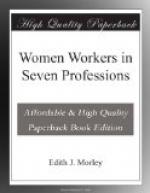To those who look for a real advance in household science the weak point of the present situation is the want of proper correlation and standardisation of the work going on. The Board of Education does not examine; it accepts the diploma given by any one of a fairly large number of domestic science schools. In consequence, teachers from different quarters may be using quite different processes and methods in laundry work, cooking, or housekeeping. It is time some fundamental things were agreed upon, and although standardising must not be allowed to become stereotyping, at present constructive generalisation is needed, as well as the upsetting of out-grown traditions. In this context it would be well to discuss a question more properly to be taken at the end of this paper—the connection between the teaching in elementary schools and that in secondary schools. There is no reason to introduce differentiation in the training of the teachers: it is obvious, for instance, that the recent development of including economics in that training, is of extraordinary value to the elementary school teacher. But it is difficult to correlate the instruction given in the management of a middle-class household, with from eight to twenty rooms, and from one to a dozen servants, with that given in the management of a workman’s cottage or of a flat without assistance. The connection which does need systematising and establishing is between the management of a middle-class house and the training of domestic servants, which ought naturally to form part of the trade or technical after-school work for elementary scholars. Here again, if training is to be followed by certificates, and the domestic servant is to be in the smallest degree an expert, some standardisation of training is necessary. We may, of course, find that domestic service becomes so much a matter of expert work that it is taken up on a large scale by middle-class girls, but that can hardly be prophesied yet, although the “lady servant” is an existing phenomenon. It is, of course, also possible that a modern curriculum of “Household and Social Science” may attract a certain number of men of the suitable type of mind. The attitude of the community is changing so rapidly that one may hope those fears to be groundless which speak of “relegating women back to the limited sphere of domesticity,” and thereby losing so much that has been gained with regard to their education.




